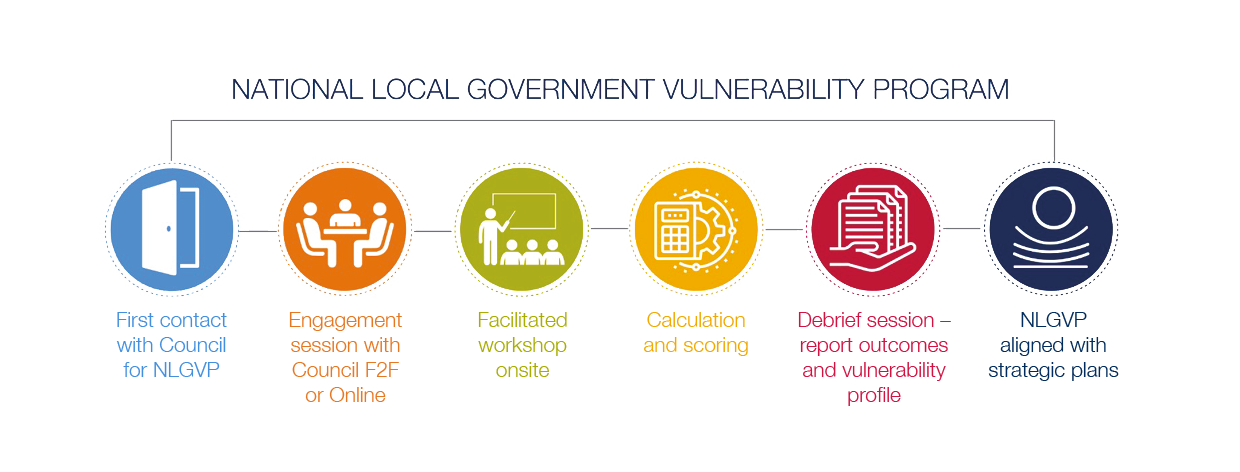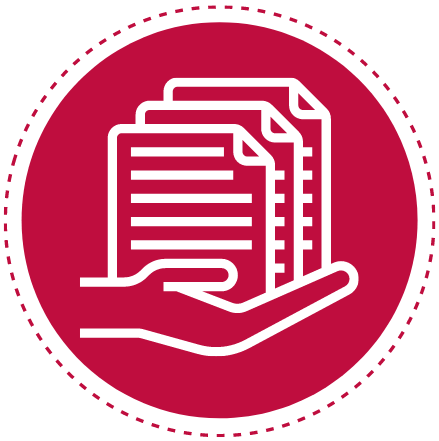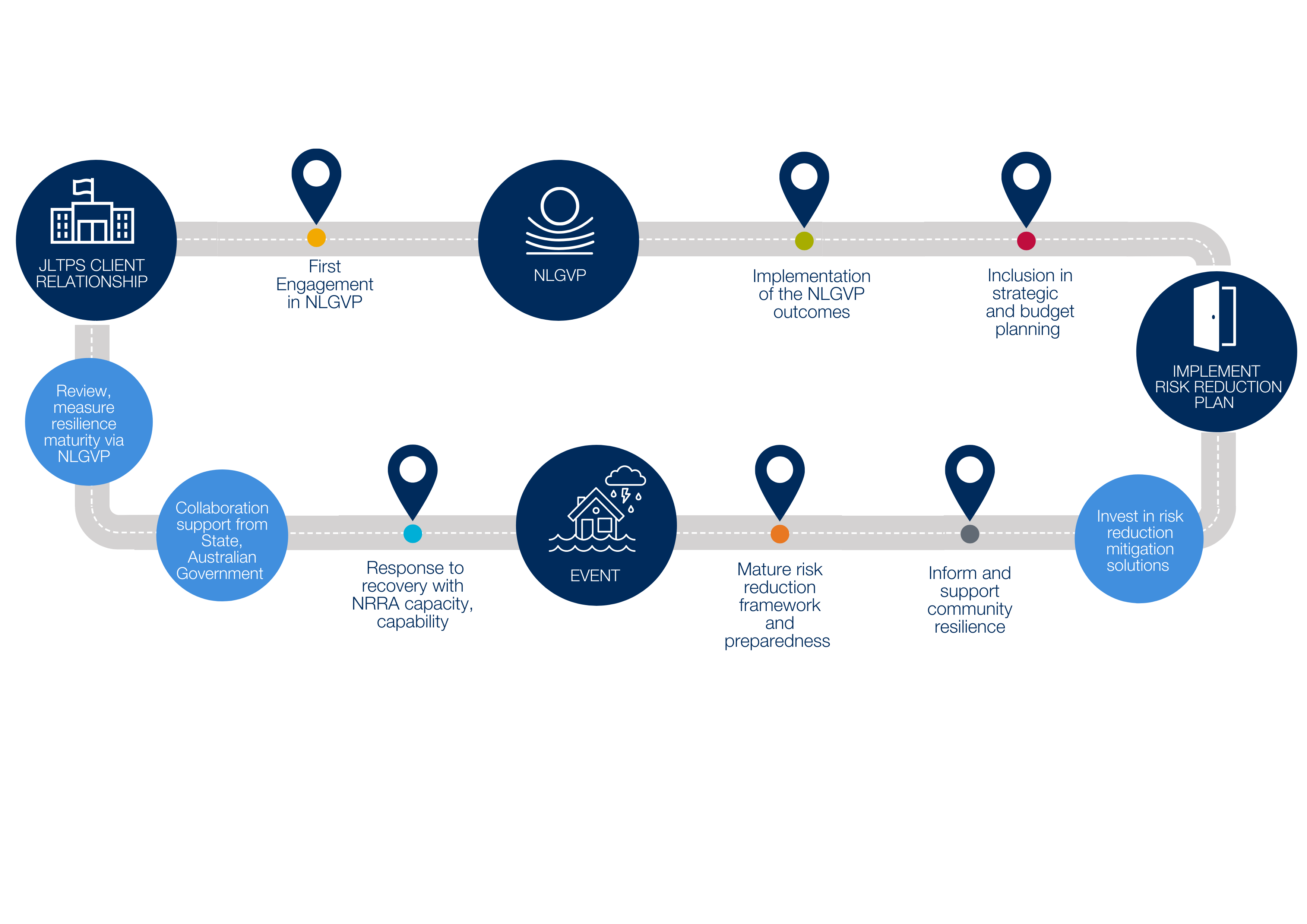New data, many benefits for councils
- By Robyn Daly

The National Local Government Vulnerability Program is led by JLT Public Sector in partnership with local government. Its purpose is to assist local governments self-assess, diagnose and capture baseline data and information about their readiness and capacity to address systemic vulnerabilities and lead their communities build disaster resilience.
A common framework adapted from the United Nations Local Government Self-Assessment Tool for Disaster Resilience is used to develop a profile upon which each local government can monitor its own progress in building institutional capability and resilience.
‘The Program recognises that local government and state government activities, irrespective of their portfolio of statutory responsibilities, already contribute in various ways to building disaster resilience.’
Role of JLT Public Sector
JLT Public Sector, as the preferred provider for whole-of-risk solutions to local government, is leading on resilience building at a local level – local, to national, to local. Building partnerships with relevant key stakeholders is an essential component, along with co-ordinating and engaging its public sector skills and resource base across all states and territories.
In this context, this program is co-designed with local government and led by JLT to assist the self-assessment of baseline level of readiness to cope with disaster, identify institutional capability gaps and re-evaluate council strategic plans and budgets.
The result will be a much clearer picture of each council’s readiness level and, when aggregated, Australia’s overall capability and capacity at the local government level. This data can inform scaling of strategic resilience interventions, contributing to the intent of Australia’s Second National Action Plan and implementation of the National Disaster Risk Reduction Framework.
The benchmark data captured because of this program will enable regular monitoring of progress and movement on the resilience scale.
Strategic alignment
The Australian Government National Disaster Risk Reduction Framework (2019) (aligned with the UN Sendai Framework for Disaster Risk Reduction) establishes a policy context which calls on all sectors to work together to reduce the impacts and costs of disasters for all Australians.
‘Natural hazards only lead to disaster if they intersect with an exposed and vulnerable society; and when consequences exceed its capacity to cope.’
Local government and the communities they serve are at the forefront of impacts of natural hazards – disasters happen to a place(s) and to the people who live, work, and play there.
For this reason, local government carries significant leadership and legislative responsibility for the safety, health, and wellbeing of its communities. Additionally, local government operates within a limited revenue stream and, as the cost of disaster escalates, insurance availability and affordability are increasingly difficult to budget for.
As the program proceeds, the level of capacity to address systemic climate and disaster risk will be emerging for LGAs across Australia, and institutional gaps that need to be addressed will be better understood. This data is highly relevant to possibly harmonising resilience activities and informing investment in mitigation across all local governments – forming a national picture of local government as an essential stakeholder in national disaster risk reduction efforts.
The program will make a direct contribution to addressing recommendations from the Royal Commission into National Disaster Funding Arrangements – that certain local government data is non-existent.
Benefits for Councils
At the end of the process, each council will have:
- Built an understanding and mindset required to navigate systemic disaster risk in uncertain times
- Undertaken a self-reflection into alignment between council operational and strategic risks
- Learnt more about its capacity to lead, build, and integrate resilience in its strategic plans to cope with future disasters
- Developed insights into where to prioritise and address systemic vulnerabilities and opportunities, and embed risk mitigation measures
- A detailed report of results from the self-assessment and a benchmark resilience score.
A tailor-made data platform underpins this work ensuring local governments have access to their own data to inform policy and strategic investment decisions, and to measure progress against multiple benchmarks aggregated and scalable to local, region, state, and national levels.
What is required from a council?
The program is delivered through six steps of engagement and is decidedly interactive and engaging.

The process outlined below requires approximately four hours of commitment by executive and senior council representatives from across all areas of council business.
 | STAGE 1 – Engagement Session Face to face or online by JLT PS with council participants to frame NLGVP process, seek authority to commit, complete Engagement Survey, schedule NLGVP program facilitation and delivery times, dates. |
 |
STAGE 2 – Facilitated workshop Workshop session face to face on council site. Data and information collected from participants via interactive and online survey tool. Survey collects quantitative /qualitative data that is scored to build vulnerability profile and calculate resilience rank. |
 | STAGE 3 – Delivery of report to council Profile data, scores and resilience rate delivered with explanation online or face to face with NLGVP participants - for informing risk reduction framework and integration into strategic, business and community plans. |
Figure 1: NLGVP three-stage process
The number of participants is at the discretion of each council, with experience showing significant value is derived from the knowledge and experience exchanged throughout the process when all senior and other key personnel across all areas of council business are involved.
Profiling vulnerability: A functional focus
In the face of intensifying natural hazards and extreme weather events, it is more urgent than ever to tackle the root cause of disaster. To do this, a better understanding of disaster risk in all its dimensions is needed. This means better understanding systemic vulnerability and using that information for good, risk-informed policy, investment, and sustainable development decisions to build resilience.
Our current risk context is complex. Working to understand this complexity is a hallmark of the National Local Government Vulnerability Program. Figure 2 (below) depicts the resilience features that are common to all levels of society (orange boxes). This program is targeted at the level of government – that is all levels of government looking through the lens of local government.
Figure 2: From Profiling Australia’s Vulnerability (Page 16)
As outlined in the report Profiling Australia’s Vulnerability, many things shape vulnerability –individually and collectively. The most important is the relationship we have with the things we value – each other, the place we live, work and play, critical services we provide, objects – and how these things are disrupted or destroyed in a disaster.
As the 2020 Royal Commission and other inquiries have found, recent extreme weather events have exposed and laid bare systemic vulnerabilities which have contributed to disaster outcomes, while revealing inherent strengths and opportunities.
Each of us have a unique combination of capabilities and capacity to cope with disaster – we are all vulnerable and resilient in different ways. We all, however, have limitations. This extends to our interconnected systems where vulnerabilities are nested within and dependent on each other.
The Profiling Australia’s Vulnerability report identified four patterns of systemic vulnerability to help understand how complex and highly dynamic systems interact. They form the basis of vulnerability discussions as part of this program:
- Placement of communities, infrastructure, and assets
- Access and supply of essential information, goods, and services
- Risk assessment, ownership, and transfer
- Governance and organised, inclusive decision-making
Recommended reading: Profiling Australia’s Vulnerability
Thinking differently: Establish a new mindset
The National Local Government Vulnerability Program is designed to measure and monitor the maturity of a council’s risk reduction framework against its strategic plan and, importantly, endorse the guiding principles that underpin the relevant Local Government Act.
The principles outlined in the Systemic Disaster Risk Handbook (2021) are incorporated in this work, to shift mindsets and change systems. These principles are based on the following foundational concepts:
- Disaster and emergency risk management is evolving to include systemic disaster risk and resilience to inform broader risk reduction efforts
- Whole-of-society involvement in managing risk is vital to resilience and reducing loss and harm caused by disasters
- Inclusive governance and risk cultures framed around place-based, systemic resilience and sustainable outcomes is key
- People and communities need tools, ability, and knowledge beyond traditional emergency management to resist, absorb, accommodate, recover, transform, and thrive in response to the effects of shocks and stresses
Program participants will be using these principles throughout workshop activities.
Recommended reading: Systemic Disaster Risk Handbook
How the program works …
Highly interactive, the program involves a bespoke simple self-assessment exercise delivered through a consistent, facilitated discussion and use of quantitative and qualitative survey methods, to identify the four pillars of vulnerability which are then classified against 10 essential indicators of local government resilience.
These 10 essential indicators, involving 50 questions, have been modelled on those developed by the UN to support the implementation of the Hyogo Framework for Action (HFA) and the Sendai Framework for Disaster Risk Reduction.
For the purposes of this program, participants are asked to consider the impacts of six natural hazards: Bushfire; Flood; Extreme Weather Event; Drought; Earthquake; and Pandemic.
Working through the 10 essential indicators each participant will independently rate each question. Ratings will be live captured in a survey tool, aggregated and averaged, resulting in a resilience score.
Results will be discussed, as the council’s vulnerability profile is identified. This new data, returned to the council in the form of scores and profiles for analysis, will be used to consider current strategic plans and budgets, inform potential adjustments to budgets, policy, plans, procedures, implementation strategies and mitigation investment.
All data will be available to council at the end of the process, accessible through a secure online kiosk.
At the end of the process each participating council will have risk profiling information as an evidence base to inform strategic, business planning and budget processes – essentially a roadmap for building institutional resilience. The National Local Government Vulnerability Program is designed to be circular (Figure 3), able to be repeated with an appropriate trigger (natural hazard event, review of strategic plan, funding submission for disaster risk mitigation projects) to produce data that will enable the measurement and monitoring of investment in disaster risk, focussed on the build of resilience.

Figure 3: From JLT Public Sector
